What would you say if I told you all of the horses in the photo below were painted with dry pigments. No, I don’t mean add a medium to turn the dry pigment into oil or acrylic paint. I mean honest to goodness application of dry pigments. If you want to learn how to paint with dry pigments, read on.
You probably think I’m nuts or the technique would be more trouble than it’s worth – or that it would wipe out detail. You could probably come up with lots of reasons not to try it.
But here you are reading this article. 😀
While I paint miniatures and various historical figures, I also paint model horses. This is a huge hobby but very few people know about it. It is very similar to the miniatures hobby, the only thing different is the focus of the subject – to create the most realistic and accurate to real life horse as possible.
It was in the model horse hobby that I learned this technique and I’d like to share it with you.
How to paint with dry pigments: Principle
The general idea is very simple. Pigments and pastels are translucent tints – meaning they are not completely opaque. You build from light to dark and slowly work toward the color you want to achieve. The top layer’s color is affected by all the layers below it.
Pigments and pastels are translucent tints – meaning they are not completely opaque. You build from light to dark and slowly work toward the color you want to achieve.Starting with a white base, you select a light color and literally stain your subject with a brush or applicator and slight pressure. When you have colored the desired surface, you seal the pigment or pastel with matte sealer. Once the sealer dries, you do it all over again. The color you end up with simply depends on where you stop.
Lighter colors, of course, take less layers. Darker colors, all the way to a rich black with blue and brown undertones can take several. Pigments are pure color, they have no binder so typically take less layers than pastels. While I use both depending on the effect I want, I prefer pigments because of the richer color and better coverage.
Before we begin, allow me to list what you may need, or a least need to know about.
Supplies
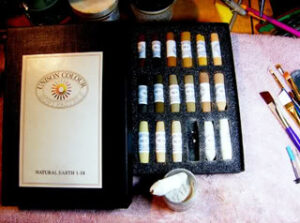
Pastels
I use both pigments and pastels depending on the desired effect I want to achieve. For pastels you need to purchase a high quality brand. Pastels are colored pigment and a binder, so they keep their stick shape. The binder does not have any color. The cheaper pastels have more binder and less pigment, therefore it takes more to achieve a desired color. The higher quality brand names such as Rembrandt, Sennlier, Unison, etc. have more pigments and less binders, so these are the ones you should focus on.
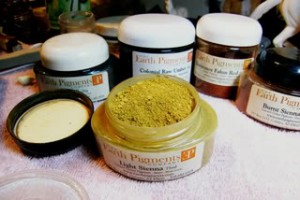
Pigments
I use exclusively Earth Pigments. There are several companies that make pigments, including many for the miniature world for use in weathering. There are also pigments sold by art supply retailers such as Dick Blick that sell powdered pigments made for the oil painter to make their own oil paints. I would like to caution the reader about these. Please check the labels! The pigments for oil paints can contain ingredients that are toxic – cadmium for Cadmium Blue for example, is toxic. If you have children and/or pets, be aware that pigment dust will get EVERYWHERE. There is really no way to control it no matter how careful you are. So know what is in your supplies.
I use Earth Pigments because they have high quality colors, they have a UV rating, their jars are inexpensive and for what we are doing this small amount will literally last years, and best of all they are NON-TOXIC. Yay! Now, they do have a warning not to breathe in the dust, so it’s a good idea to have a mask, especially if you’re sensitive to things like this. But as a whole, Earth Pigments have a lot of fantastic things going for them.
For those of you in Europe, I have a link (I need to dig it up) for a company that is sorta like Earth Pigments “sister” site, where you can get the same thing. I believe they are in France.
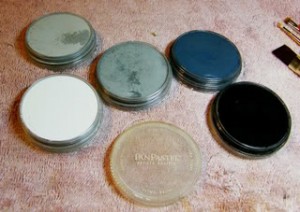
Pan pastels
Like regular pastels, pan pastels are pigment mixed with a binder. But these are pressed into a small pan – very much like a make up compact – so the binders are far less than regular stick pastels. They have fantastic color and go on smooth. Once again they are easily available and not that expensive. I like using the Grays Set of 5 from Dick Blick. But they come in a huge variety of colors, tints and shades, so if you want to get others, go right ahead! These little pans actually screw together to form a stack, so everything stays neat and tidy and they are easy to store.
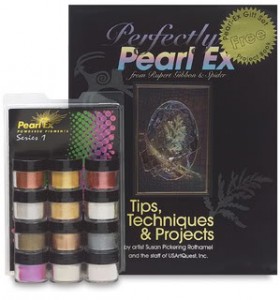
Pearl Ex metallic pigments
Not required for the first couple of projects but trust me, if you don’t get them you’ll soon wish you had. These are fantastic for armor and for horses you add just a touch to get the nice sheen of a healthy coat. I have the Series 1 12 Color Set with Free Book except for the neon violet color, all of the other colors work perfectly for armor, metal items, and natural horse colors. But honestly, if I had the money to get all 32 colors, I would! With these comes one caveat….

Colour shapers
if you get the Pearl Ex metallic pigments you really need to get the colour shapers. While I want to demonstrate and explain the products I use, I don’t want to say YOU MUST BUY THIS. But these two items go hand in hand and my experience with the generic brands has been poor, so these are the ones I strongly encourage you to get.
I tried applying with a brush and POOF glittery dust explosion everywhere! I tried mixing them with the pigment powder but it was either ineffective or I still had glittery dust everywhere.When I first started using the Pearl Ex, I did not have these and I absolutely hated the pigment. I tried applying with a brush and POOF glittery dust explosion everywhere! I tried mixing them with the pigment powder but it was either ineffective or I still had glittery dust everywhere. These things were so hard to control and to apply where I wanted that I just about threw them in the trash. I’m glad I didn’t.
Out of sheer luck I found the Colour Shapers on Dick Blick and decided to try them. They worked nicely, they are a non-porous rubber so you can use them for paint or glue and just wipe them off afterward. Stuff doesn’t stick to them. In desperation, I tried them to apply the Pearl Ex. It worked like a charm! Now I have almost complete control of application and can apply them onto even the smallest piece of armor. Or I can apply metallic pigment to a large muscle on the horse to get that realistic sheen and not worry about it flying into areas where I don’t need it.
Colour Shapers just came out with a Mini Set that is perfect for our jobs. I purchased the Firm set then went back and purchased the extra firm set (Clay Shapers). I use them both depending on the job at hand. Whichever one you get depends on your style but you will really love these when it comes time to apply the metallics. Trust me on this one! You’re gonna want the Mini set Size 0.

Primer
Another must have. You will need white at the very least. I prep my horses then apply gray primer because the contrast on the larger scale helps me see anything I missed. (When working on miniatures, I only use white because I don’t want the added layers.) Then I cover the model in white primer.
My favorite brand is Tamiya Fine Surface Primer, both white and gray but at the time of this writing, Tamiya aerosol cans of any sort are not allowed in the U.S. Due to labeling issues. My second choice (and it’s not far behind Tamiya in quality), Is Vallejo White and Vallejo Gray aerosol primers, in fact, I may stick with it even if Tamiya comes back. I tested it first and while it’s a bit too easy to over apply and get it to run, it applies nicely and does not cover fine detail.
Basically you want a high quality white primer that has enough “tooth” for the pigments to stick to but not too much or there will be difficulties with grain down the road. No matter what brand, you MUST prime white as the last step. In order to properly apply pigments and pastels, you must have a white base coat to start.

Matte sealer
I use Testors Dull Cote because it is very matte and is non-yellowing. Plus, it provides the right amount of tooth. If your preference is more towards glossy figures, you can use gloss sealer but be aware gloss has less tooth and it will be more difficult to apply the pigment.

The sealer I use is Testors Dull Cote. It’s an acrylic lacquer I believe. Many figure and mini painters use it, especially if they game with their minis. I know folks who don’t game are moving away from sealer because there is too great of a chance of that sealer doing strange things and ruining their hard work. This is why I always spray a test model first, no matter how many times I’ve used that can of sealer.
Certain sealers can react with the primer even if you have several layers in between.I use the same sealer for all of it, paint, pigment, pastels. The type of sealer you use is entirely up to you and if you have a brand preference. But also be aware that certain sealers can react with the primer even if you have several layers in between. That happened to a friend of mine. She started using Tamiya primer, painted a horse using the exact same technique I just described, but when she applied Krylon clear sealer, it started to bubble and everything down to the primer just flaked off. We ended up contacting Tamiya USA and while they had never heard of this happening before, they said it sounded like the Krylon sealer and their primer were not compatible. Anyway, she went back to Testors and everything has been just fine ever since.
I even use the Dull Cote on the metallics. Yes, it dulls them down just a little but I can usually get three layers of spraying Dull Cote on the mini before it dulls the metallics completely.
Nylon brushes
For applying pigments and pastels you do NOT want to use your good paint brushes. Now is the time for the cheap nylon that can stand up to anything you throw at them. Applying this stuff is hard on brushes and you need the kind that is not too soft or you will hit the brush ferrule against the mini. So get the white nylon brushes that are on sale at Walmart or Michaels for next to nothing. The assorted shapes such as the filbert, flat shader and angled shader also come in handy.

Bead jars
The stackable type come in very handy for mixing pigments and using with pastel sticks. If you take a jar and a pastel stick, hold the stick over the jar and drag the stick against the edge moving inside out, it will grind the stick into powder and the powder just falls right into the jar….for the most part.
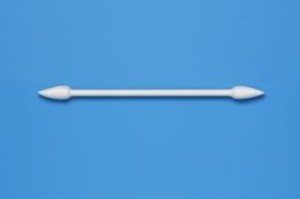
Other supplies
Various grits (180 to as high as you can find them) sanding sponges. Do not use sandpaper! Pointed cotton swabs from the make up aisle at Walmart or Walgreens, etc. the cheapies are just as important as the expensive ones, Tamiya pointed cotton swabs, Canned Air – the same stuff you use for electronics. Colored Pencils – such as Derwent (not water color), Black Charcoal Pencil, White Charcoal Pencil, Brush on Gloss, Gesso (or white brush-on primer), and a Carbide Scraper are all very handy. Don’t put your acrylics and brushes away just yet! You’ll still need those.
Painting: How to apply dry pigments and pastels
I have a Work In Progress thread going on CMON and I used a knight’s cloak as an example of how to apply dry pigments. So I’m going to draw on those photos for the purposes of this article. The character in question is Pegaso‘s Roaming Knight and I had started painting the cloak with acrylics, then decided to apply pigments instead and used the example of why we must start with a white base when using pigments and pastels.
So, our knight is starting of with a standard acrylic layer of paint, a sort of olive drab – think of the old army blankets. It’s nothing special, I had wet-blended the acrylic and finished the first layer. Then I decided to switch to pigments.
It is important to understand that pastels and pigments are tints. They are translucent and the first color will show through the second color. The two combine to give you a shade. Start with white primer (or white paint) as a base. It is also important to work from light to dark. So the next step was deciding on the color of pigments I wanted to use.
Note: Because of my hand tremors and the way I need to work, I’m only going to be working on one side of the cloak at a time since I have to lay the model down to work on it. As you can see, I layer towels and do all I can to protect the work I’ve already done.
Light Sienna
I haven’t used this color at all because it has a strong green undertone and is quite inappropriate for horses. So here it sits, waiting. Now was a perfect opportunity to try it out. I purchased these several years ago, before Earth Pigments had accurate photos up, so the strong green undertone didn’t come through until it arrived and I opened the jar.
Natural Umber
This is another strong green undertone color that I haven’t had the chance to use.
Natural Black
A friend sent this to me to try. This is a relatively new color in the Earth Pigment line. There is another black, an Oxide pigment, Black 318 that is very strong and very intense. It is so strong, it can wipe out almost anything and everything else. Natural Black is softer, and the blue undertone is supposed to be less.
So these are the colors I decided to start with and I’m prepared to adjust as I go. Applying pigments and the color achieved is not an exact science. No matter how often I work with them, they can still surprise me and do so quite often.
Why you need a white base
In order to demonstrate the need for a white base, I start by applying the Light Sienna directly to the knight’s green acrylic painted cloak. I’m not shy about it either. I put my brush into the pigment and load it up. Then I tap off the excess on the side of the jar – otherwise you will have a cloud of dust that won’t quit. I firmly press the brush against the cloak but not so hard that I push the ferrule into it. I use a slight stippling motion with a drag to apply the pigments. I’m literally staining the cloak as I go.
In order to get really solid coverage of pigment. I get my Colour Shaper out and use that to press the pigment onto the cloak. When it’s finally covered, I take my canned air and blow off the excess dust. This is an important step. If the excess powder remains, and sealer is applied, it literally turns to mud. Now if we were truly weathering, we might want this effect but for this, we don’t.
You can also use lung power to blow of the dust but I guarantee if you do, sooner or later you’re going to spit on your work. Trust me, it’s happened to me more times than I care to count and it will happen to you eventually. When that happens, set the model aside to dry. If you don’t mess with it, it should disappear on its own.You can also use lung power to blow of the dust but I guarantee if you do, sooner or later you’re going to spit on your work.
Once the excess dust is blown off it is time to seal. Take the Dull Cote and be sure to shake well! In fact, it’s a good idea to have a test model handy because cans have been known to freak out and do crazy things in the middle of spraying. So hitting a test model first is better than ruining your hard work.
You want to lightly cover the area with pigment. Do not soak it, do not let it puddle. In fact, 2-4 very light coats of sealer is the way to go. It also depends on the size of the model, a large one will need more than a small one. The really small ones you need to be very careful of how many layers and how thick you apply so you don’t obscure fine detail.
Now our sealer is applied and what do we have to show for it?
A big mess! The pigments actually disappeared against the dark base coat. The only thing that remains are the yucky spots where I applied too much pigment and too much sealer. I’ve circled the problem areas in the photo and did this to make a couple of important points. If you do not use a white base, your pigments will most likely disappear. You will also probably attempt to apply them too thick and end up with mud as in the photo.
The above photo looks absolutely atrocious.
But I also want to point something out. Even though our pigment disappeared agains the dark base, if you look closely where I have the blue arrows, you can see where some of it did highlight an area or two. The effect is very subtle and difficult to see, but it is there.
So now what do we do? Is our knight hopeless because I applied pigment to a dark basecoat? Do I have to strip him?
No – he is still very manageable. With a little effort he will be right as rain.
The first thing I do is use a high grit sanding sponge – a sponge, not sandpaper to lightly sand off the pigment mud and goobers left behind. Sandpaper will crease and gouge the layers, many times damaging your basecoat.
I don’t even have to strip the cloak, just get the nasties off. Once I do that, I take Gesso and thin it really well. Gesso is infamous for leaving brush strokes so you want it good and thin. If you don’t have Gesso, in this particular case – recovering from a mistake – brush on primer will work just as well. I recently purchased Vallejo’s White Brush-On Primer and I love that stuff! Gesso is out the door unless I’m out of the Vallejo.
I apply two layers of Gesso to the cloak. Now we have our white basecoat and can move forward.
Layer one
Remember always apply colors light to dark. You need to work in layers. Trying to rush to a darker color will only lead to problems. You are basically working with colored dirt here. Ochers and Oxide pigments are like little grains of sand. They don’t dissolve. You press them into your base until there is no more surface area for the grains to adhere to. Once the layer has reached its “saturation level” the pigment color will stop growing darker or denser. That means it’s time to seal.
<span=”inset-right”>Once the layer has reached its “saturation level” the pigment color will stop growing darker or denserApplying sealer keeps the tiny pigment grains in place. It also provides a new, relatively clean surface area for more grit to adhere to so you can apply another layer. But rushing this and going dark too fast can cause grain, an ugly mish-mash of uneven pigment.
Grain shows up the worst when you move to a darker color and you will need to either go back a step and return to applying the lighter color, or try to lightly sand it out without messing up your basecoat. Sometimes both! So make sure you have good coverage and don’t go dark too soon, that’s the best way to avoid the hassle with grain.
First, I apply a layer of Light Sienna.
Already it looks totally different and much much better! It’s a little streaky but that’s okay, more often than not the sealer application will darken the color and tone that down. The cloak now has a soft golden look to it. After blowing off the excess, I apply my sealer.
Will you look at that! The picture above looks NOTHING like that green disaster we had a short time ago! Now I wait for the sealer to dry, approximately 20 minutes but this may vary depending on the weather and humidity in your area.
Layer two
As mentioned previously, I don’t want grain so I don’t go too dark too fast. I apply a second layer of Light Sienna and seal.
Notice how this time we have a lot more green undertone than previous. As I said, pigments and pastels are tints and translucent so basic color theory will start to apply.
How do you know when to apply one coat, two coat, or more of a certain color? For the most part, that is just going to come with experience and seeing how the colors lay down in various situations.
In this case, I don’t want any more green at this light color. Because of my planned colors, I know I’m going to get more green as I go but right now, want to go darker before we go greener. Make sense?
Layer three
Now, I apply the Natural Umber. WOW! Major green going on here! Lol! This is not only going dark, it’s going REALLY green. So I decide one layer is enough. I don’t want the cloak to be the same color of green as the scented Pine deoderizer hanging from the review mirror in somebody’s car.
Layer four
So let’s jump straight to the black. Now in this case, we want to use the black for shadows only. If we cover the entire cloak, it will go way too dark. I start by applying the Natural Black – or at least trying to. Unfortunately, even with the Colour Shaper applicators, the color has no strength to it at all. It’s going to take me forever at this rate. So I pull out my Black 318. Remember I said this stuff was strong? Check this out:
Yeah, this was supposed to be a minimal application. I don’t think “minimal” is in the dictionary when it comes to this black oxide.
So I seal layer four and look what I have as a result. The cloak just swerved a hard right from green to brown. See, I told you these things can still surprise me.
Now here is the fun part. This is where I get to show you how to do what I said (and demonstrated) earlier what NOT to do! 😆
Layer five
I am going to apply a lighter color on top of a dark color, specifically a light brown. The cloak is now going too dark. There’s just too much “muck”. Again, this isn’t an exact science so you are going to get color twists and curves that you have to learn how to handle. Again, experience is the best teacher to know if you can work through it or if you have to strip it and start over. Always do you best to work through it, over it, sideways…something! Leave stripping as a last resort.
Experience also teaches you how various colors and types of pigments (this includes pastels too) will react. I mentioned the Black 318 is one of the strongest oxide pigments I have. Well, I have another oxide pigment that is strong, has great coverage and can almost handle anything thrown at it. It comes in a strong second to the Black 318. It is Titanium White.
The only problem, Titanium White has a very, very strong blue undertone. I’ve had it turn my stuff purple more times than I care to count! So I’ve learned to offset this with basic color theory and adding a color to the mix to help neutralize that blue undertone. In this case it is Light Yellow Ochre. The mix turns into a buff color and I apply a layer.
As before with the green, you see I have a very stark contrast between the light color and my original green/black. But I haven’t sealed yet and that is the key.
Upon application of the sealer, the light color does as before it nearly disappears completely. But if you look closely you can see where the light tan stuck and while it is still subtle, it stuck with a lot more strength than our first attempt.
It’s all about learning what specific types of oxides and ochers, as well as colors, can do.
Layer six, seven, and eight
I stay with this buff color for these next three layers. I need to mention these are specifically applied with the Colour Shapers and each layer sealed. What a difference in that photo above, huh? 🙂 And although I’m keeping my layers and sealer thin, we still don’t want to apply too many. So here is where I call the inside of the cloak done. Check out this last photograph!
The back of the cloak – leather effect
Above we achieved a nice light color with dark shadows. To me, the inside of the cloak looks like Oil Skin. But I would like to show you some quick and easy steps to create a true leather effect. Our first layer of color is as before Light Sienna and seal. For the second layer, this time I go ahead and go slightly darker – not much, just a little and apply a soft red color with a hint of orange called Rose Earth and I seal that as well.
Third and fourth layers
This is another new color called Cypress Umber Warm. Umbers have a tendency to posses a strong cool cast, basically blues and greens. This one has a warmer cast to it and I wanted to see how it would work. After sealing I immediately moved to the Black 318 but using my Colour Shapers I was very cautious to only apply it to the deepest recesses.
And wow – instant leather! And this is only four layers folks!
Fifth layer
So what do I do after the sealer dries? I go and break my own rules again. At this rate, you’re not going to take me seriously! Lol! The Colour Shaders have a tip called a Cup Chisel. I used this and returned to my second layer color, Rose Earth. This time I applied it ONLY to the highest points on the folds of the cloak. The Cup Chisel works perfectly for this shape. And once again I sealed.
Sixth layer
Again repeating the Rose Earth highlights with the Cup Chisel and sealing.
Seventh layer
The insanity strikes again. Instead of going lighter on the high points of the cloak, this time I went redder. I used Colonial Red pigment and it is red without having a lot of orange but it’s not BRIGHT RED either.
I got interesting results so after I sealed I took a series of pictures. The only editing I did was to crop, resize and put them into a panel. The changes you see are only angle of camera and lightly. They are very small adjustments but you can see the effect this achieved.
Each panel appears to be different stages of pigment application but they are not. This is one application and the only thing changing is the position of the figure and the angle I’m holding the camera.
My friends, in my humble opinion, that is leather.
All of this created with dry pigments and “painting”.
A few words about metallics
Now this helm I did entirely with metallics and sealed with Dull Cote. I have different colors of silver metallics, just like we have different colors of silver paint. I used them for highlights and shadows just as if they were paint.
I do need to mention metallic pigments are an entirely different critter from regular pigments. They are NOT translucent and you need to use a black base coat with them, unlike the white of the regular pigments. Black allows them to pop. If you use white or a light colored base, they go kinda soft pastel colors rather than having the zing they normally do.
And here is a photo of the miniature we were painting. (Still very much a WIP)
I hope you’ve enjoyed this article and found it informative. Please comment if you have any questions! I am happy to help however I can.
— Kathryn
Now that you know about the art of painting with dry pigments, why not add this technique to your miniature painting toolkit? If you’re still honing your skills or simply want your miniatures to stand out, our professional miniature painting service is here to help. Reach out today to arrange a free consultation and discover how we can bring your miniatures to life.



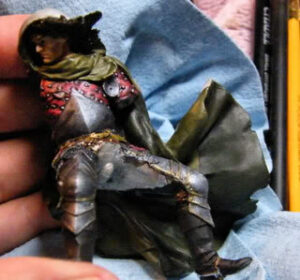
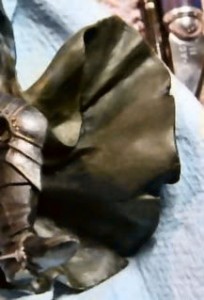
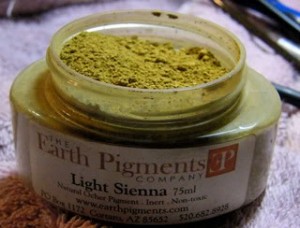
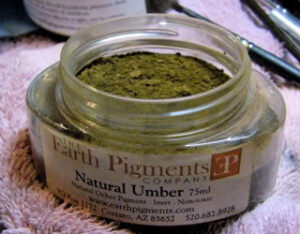

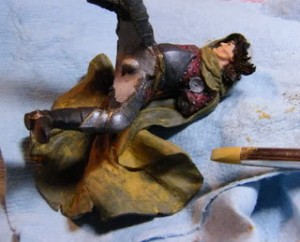

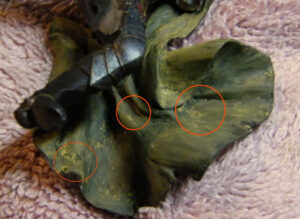



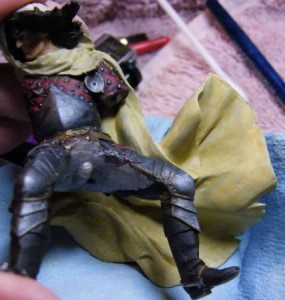


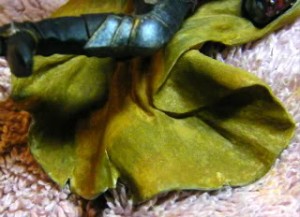
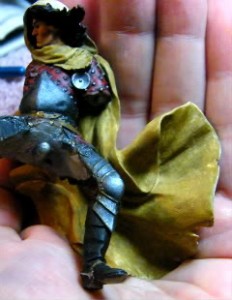
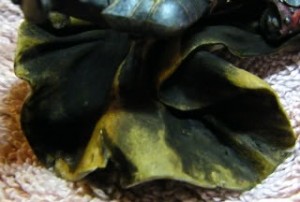


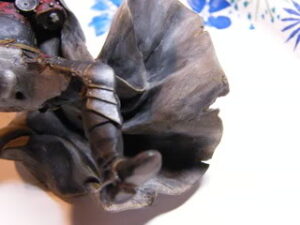

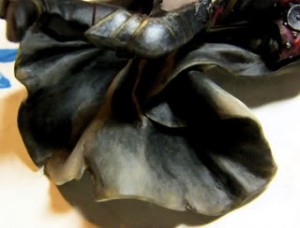
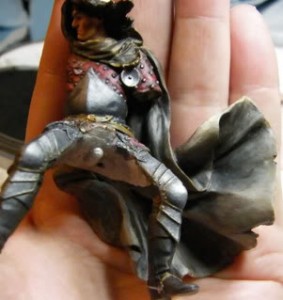




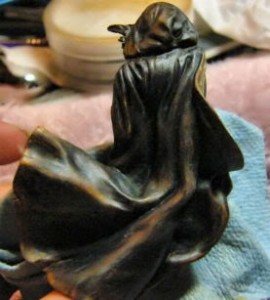






I used a very similar technique with dry pigments, and I discovered it by total accident when I was weathering my German tanks in 1/72 scale.
I applied weathering pigments onto the model and they looked really cool and dusty, but I had to varnish the surface to protect the pigments from being rubbed off. I sprayed some matte varnish on the model and when it was dry the pigments wonderfully blended with the underlying paint. Wow, I said, what an easy method for smooth blending of very different colors (panzer grey and earthy brown in that case). Maybe not suitable for tiny details and surfaces, but for larger ones it can be perfect!
Thanks for sharing so much additional info, not only the step-by-step guide. Well done!
I am a beginner and hopefully I will be able to apply those step by step applications as well. Thanks
awesome write up Kat! Great Work.
Tee
Insipirational writeup. I just used pigments for effects until now, but I will try them for paintwork now…
Great tutorial! Thank you very much!!
Thank you everyone! And thank you Mahon for all the hard work in getting it posted. If anyone has any questions, please don’t hesitate to ask.
Fantastic! Are there any books on this subject that you can recommend?
I really like the look of this and I’d love for the author to separate the various pigments and pastels that they’ve tried into what is really needed to have a decent crack at the technique pile versus the ‘unnecessary’ but certainly nice if you’ve got them pile.
Hey gang! So sorry I’ve been away for so long. I had a job I was working major overtime at and it left me absolutely zero time! But it’s done and I’m back now.
Gobbo – my apologies, the only book I’ve seen on the subject is by Jaime Baker. Unfortunately the book is out of print. She does have a DVD series she’s been working on where she shows the application of pastels and pigments on model horses. These DVD’s concentrate on realistic horse colors so I’m not sure how much you’ll get out of them. Of course if you have a cavalry to paint, the DVD’s will be fantastic.
Paradoxrifts – again my apologies in the delay answering your question. I’m not sure I understand your question. Are you looking for specific colors? If that is the case, it completely depends on what you’re painting. To start, you can go to a local art store and buy a box of assorted quality pastels- at least 12, 24 is best. Those generally have enough colors to give you enough to work with and you can experiment to see if you would like to invest. If you are in the US, Earth Pigment jars are generally a couple of bucks and you get a lot for the money.
For natural colors (remember I started painting horses) with pigments I started with light sienna, dark sienna, yellow ocher, dark yellow ocher, brown ocher, brown 610 (it lays down with a lot of red undertone but is dense and helps if you have grain pop up) burnt sienna and burnt umber. I also had black 318 and Titanium White. Earth Pigments are adding more colors all the time so now you can get a variety of blues, reds and greens – even a purple or two. You can also mix these colors in separate containers to give yourself an even greater variety. (Be sure to make notes of your mixes so you can replicate the color – I always use old measuring spoons.) I hope that helps!
Thanks for additional information, Kathryn. Always interesting to read!
Thank you for this valuable info. I live in Europe, do you know the name of the Earth Pigment product here? Thank you!
Thank you so much for your article! i used your technics and advice to create a spectacular aged metal affect on a soldier mini’s armor and sword, then created a subtle bronze metal ring on his shield. I used Reaper’s True Silver paint mixed with Pearl Ex’s Antique Silver on a black primer. Then I used the Ultra Bronze gently brushed and rubbed in with my finger.
I really appreciate you putting so much effort in this post. I have been painting figures for years but somehow I had never come across this system. Your explanation was one of the best “How to” I’ve seen. And you even use english correctly (no “your” for “you’re”, etc.) ! ! !
Hi,
A really interesting tutorial, thank you for your hard work in producing it, you mention a European (French ? ) outlet for the Earth pigments, were you able to find the link?
Many thanks for the fantastic article!
I have been playing around with pigments and found this page, much to my delight 🙂
I have a question though, or rather a need for some advice. I used pigment to highlight a model and then used a pigment fixer but instead of fixing it, the highlight vanished. I then did the same thing but used a mat varnish in my airbrush, only for the highlight work to again vanish.
Any ideas on what I am doing wrong?
Thanks again!
Hi Phill,
So glad you found the article helpful!
I have a feeling you’re trying to cover an area that’s too dark with the highlight pigment. It’s typically best to build from light to dark, makes it difficult to place highlights, I know. But it can be done with a little practice.
Trying to cover dark colors with a light pigment, unless you have something uber strong like an oxide, can be done, but you’ll be applying so many layers, it will drive you insane! lol!
Check out my Youtube channel for more vids on painting with pigments. Those might help you as well.
Thanks for the tip 🙂
I am going to check out your channel now!
I do like your painting and I play with all kinds of pigments. After my first goof and 2 hour cleanup I’m very careful with them. I don’t argue the point that some of them can be quite toxic but the ones you seem to like (Earth Pigments) are certainly not pure pigments as you seem to think. Most are mixed with (or fixed on) a filler, usually calcium carbonate or aluminum hydrate which are white and tend to give the pigments a pastel look. In a vehicle of oil or gum they’re clear. So the point here is that Earth Pigments does tend to use the safer pigments but they certainly are far from pure.
Your work is astounding. Amazing. I’ve never seen such patience. I was curious about what pigments were so I googled and found your site. I am a diy crafting 60 year young grandma and I could never do what you do but I had to leave you a lil note because I am so amazed at the beauty you achieved from little pots of pigment. BEAUTIFUL.
Rest in Peace, Kat. Thanks for everything 🙂
Thank you for a great article! Your process is so methodical and inspiring. I actually found your post while looking for tips on incorporating dry pigment into my watercolor paintings–I’ve seen some artists do that and loved the effect, but it’s hard to find info on that. Have you come across any information about incorporating dry pigments into flat paintings? I know a lot of what you said about building up layers and color theory applies, but of course there are a lot of differences too. Thank you!
Thank you for a great article! Your process is so methodical and inspiring. I actually found your post while looking for tips on incorporating dry pigment into my watercolor paintings–I’ve seen some artists do that and loved the effect, but it’s hard to find info on that. Have you come across any information about incorporating dry pigments into flat paintings? I know a lot of what you said about building up layers and color theory applies, but of course there are a lot of differences too. Thank you!
While I don’t do anything like you’re doing (these models), I am so happy I found your site. I’ve been interested in using pigments for embellishing on decoupage and acrylic painting and was unsure how far that could be taken. All of your info about layering (and those rubber tipped things for mica powders) was very helpful. Thank you 🙂 BTW, instead of buying cans of air, there are tiny hand held blowers for people who do alcohol inks. Just saw one used in a Youtube last night.